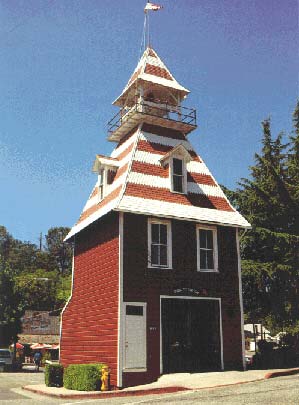

auburn-firehse - $$4.00
Before becoming one of Auburn's most famous attractions, this firehouse was home to the Auburn Volunteer Fire Department in Auburn, California, one of the oldest volunteer groups west of the Mississippi. Organized in 1852, this group is still fighting fires around Auburn California. Model thanks to long time pal Sparky
Famous Old Auburn Fire House

![]()
Before becoming one of Auburn's most famous attractions, this firehouse was home to the Auburn Volunteer Fire Department in Auburn, California, one of the oldest volunteer groups west of the Mississippi. Organized in 1852, this group is still fighting Auburn fires.
At the back of the building there is a single story shed roof lean to, evidently an addition to accommodate longer vehicles. A steeply pitched roof rises above the second story to the bell tower where the bell still chimes at 8 a.m., 12 noon and 5 p.m.
The architectural development of Auburn began as did the town- as a mining camp - and gradually grew from canvas tents to buildings of wood, metal, brick and plaster. The evolution of rough camp to refined town occurred as services and industry expanded, and Auburn became the regional center for commerce and transportation during the second half of the 19th century.
 The arrival of the railroad and the expansion of commerce and industry establishing East Auburn announced that the Industrial Age was here. By changing manufacturing methods and materials,the new Industrial Age technology created a great and varied supply of products and services available to the people of Auburn and also provided increasing wealth for Auburn's middle class.
The arrival of the railroad and the expansion of commerce and industry establishing East Auburn announced that the Industrial Age was here. By changing manufacturing methods and materials,the new Industrial Age technology created a great and varied supply of products and services available to the people of Auburn and also provided increasing wealth for Auburn's middle class.
This emerging middle class had money to spend on goods produced by the new technology - mass-produced furniture, fabrics, moldings,and the like. There was new demand for more intricate and detailed products that were once only available to the rich. Simple building designs no longer sufficed - Auburn's late 19th century shop sand homes exploded in an elaborate array of materials, styles,ornamentation, and silhouettes.
Building design during the late 19th and early 20th century was inspired by the antique styles of Greece, Italy, France, England,Spain, Mexico, and even the United States. Auburnites, like other people of the time, were interested in using elements of these styles in their own buildings. Revivals, or reinterpretations of antique styles, were build throughout Auburn and created a town that showed the artistic enthusiasm of that time. Combined with the technology of the Industrial Revolution, a growing middle class, and an interest in Revivals; architectural style blossomed in a way that has yet to be repeated.
In the late 19th century when revivalism, ornamentation, and mass production were very popular design elements, there began an undercurrent of protests by those who valued pre industrial Age craftsmanship. The result was the birth of simple, practical,functional designs that sometimes had no reference to the antique styles. Auburn homes influenced by the Craftsman style were not afraid to show unadorned structural members, the use of rustic or natural building materials, or their simple and functional design.
As you walk through Auburn, keep in mind that fires were the bane of Mother Lode communities. These fires had a profound effect on architectural styles of commercial buildings. Auburn was no exception. Its tinder-dry wooden structures burned frequently,particularly in Old Town. Later commercial buildings were usually built of brick, with iron shutters, and were basic boxes with simple Classic Revival features like simulated columns, pediments and false fronts.
Look for clues that speak of Industrial Age technology,of examples in revivals, pride in workmanship, and mid-19th century commercial buildings. Stylistic influences common in Auburn are Queen Anne, East lake, Greek Revival, Beau Arts, Gothic Revival,WPA Modern, Craftsman Bungalow, and Mission Revival. Each style speaks of bygone days, of forgotten pleasures, and most importantly,of our own family legacy.





